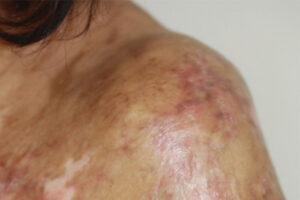Oncology
Chronic Graft-versus-Host Disease
Approach to Steroid-Refractory Chronic Graft-versus-Host Disease
Many patients with chronic graft-versus-host disease (cGVHD) become steroid refractory. The management of steroid-refractory cGVHD is challenging because disease exacerbations are frequent when steroid discontinuation is attempted. Treatment is largely patient specific and is based on several factors, including long-term safety and toxicity concerns, financial considerations, and site-specific response rates.
Steroids have been the mainstay initial therapy for patients with cGVHD requiring systemic therapy to manage their symptoms. It can be somewhat subjective for providers to determine when to initiate steroid therapy in patients with cGVHD. The typical dose of steroids is 0.25 to 1 mg/kg per day of prednisone equivalent for 4 to 10 weeks, depending on the severity of cGVHD manifestations.
For patients who receive prednisone for a few weeks but whose cGVHD worsens, especially while receiving a higher dose, we want to add more agents. For those who are partially responding at these doses, we may be willing to wait somewhat longer before declaring that they need additional treatments. A subpopulation of patients may respond to a somewhat higher dose in the range of 0.5 to 1 mg/kg per day, but we do not want to leave them on high doses for lengthy periods of time. As we all know, short-term steroid therapy can be okay, but toxicity is a big problem for patients on chronic steroids. If cGVHD manifestations flare as we try to lower the steroid dose, that may indicate that the patient’s symptom control is steroid dependent.
The response rates to steroids among individuals with cGVHD vary widely in the published literature, which I think speaks to patient and transplant characteristics, but ranges somewhere between 40% and 50%. More of a response is potentially seen in early stages of disease or in those with milder manifestations, while less of a response is seen in more advanced stages. For patients with visceral involvement, the response rates to steroids are likely to be relatively low.
In terms of subsequent agents to consider for patients with steroid-refractory cGVHD, clinicians have tried a variety of different agents over the years. If we restrict ourselves to agents that are currently US Food and Drug Administration (FDA) approved, at this point, the best-quality randomized data are with ruxolitinib. There are additional agents that are also FDA approved, including the ROCK2 inhibitor belumosudil and the BTK/ITK inhibitor ibrutinib. These agents can be considered for patients based on multiple factors, including long-term safety and toxicity concerns, financial considerations, and site-specific response rates, especially for those with more time-sensitive and difficult-to-treat manifestations such as bronchiolitis obliterans.
A patient with steroid-refractory cGVHD will be best served by a multidisciplinary clinic or group that specializes in the treatment of patients with cGVHD. The goal when treating patients with steroids is to improve the signs and symptoms of cGVHD without making patients worse over the long-term. Working with a specialized multidisciplinary team may allow patients to receive steroid-sparing treatment options to manage symptoms. For example, after receiving a full evaluation and discussing a plan of care, some patients may benefit from photodynamic therapy or extracorporeal photopheresis.
Managing steroid-refractory cGVHD requires a fair amount of art because a patient’s symptoms can wax and wane. Adding to the challenge is that the physician’s impression of symptom severity may be very different than the patient’s impression. Providers may underestimate how impactful various symptoms are, so the evaluation of patient-reported outcomes is critically important in assessing how well we are managing the disease.
It is also important to note that we see very few complete responses with any agent. Benefits often wane over time, and, in my experience, patients will have flares with cGVHD when they get something like a viral infection. During these flares, you sometimes have to adjust their medication doses. So, it is very difficult to perform the types of clinical trials that we want done to demonstrate how effective agents are.
When a patient with cGVHD is responding to therapy, you often do not know if they are at the edge of a cliff or if they are deep in a great response. Right now, the only way to assess this is to taper the medication and see what happens. It would be helpful if we had more objective methods to assess the degree of impact that cGVHD may have on different organ systems. I want to also highlight financial toxicity because we are seeing a lot of insurance denials in patients with steroid-refractory cGVHD that we have not seen in a while.
Overall, our approach to steroid-refractory cGVHD is to mostly go to ruxolitinib first, based on the quality of evidence. I have some concerns about its long-term use, however, and any increased risks associated with that because these data have not been published, and treatments for cGVHD are often used long-term.
Cutler C, Lee SJ, Arai S, et al. Belumosudil for chronic graft-versus-host disease after 2 or more prior lines of therapy: the ROCKstar study [published correction appears in Blood. 2022;139(11):1772]. Blood. 2021;138(22):2278-2289. doi:10.1182/blood.2021012021
Jaglowski SM, Blazar BR. How ibrutinib, a B-cell malignancy drug, became an FDA-approved second-line therapy for steroid-resistant chronic GVHD. Blood Adv. 2018;2(15):2012-2019. doi:10.1182/bloodadvances.2018013060
Sarantopoulos S, Cardones AR, Sullivan KM. How I treat refractory chronic graft-versus-host disease. Blood. 2019;133(11):1191-1200. doi:10.1182/blood-2018-04-785899
Waller EK, Miklos D, Cutler C, et al. Ibrutinib for chronic graft-versus-host disease after failure of prior therapy: 1-year update of a phase 1b/2 study. Biol Blood Marrow Transplant. 2019;25(10):2002-2007. doi:10.1016/j.bbmt.2019.06.023
Wolff D, Fatobene G, Rocha V, Kröger N, Flowers ME. Steroid-refractory chronic graft-versus-host disease: treatment options and patient management. Bone Marrow Transplant. 2021;56(9):2079-2087. doi:10.1038/s41409-021-01389-5
Zeiser R, Lee SJ. Three US Food and Drug Administration-approved therapies for chronic GVHD. Blood. 2022;139(11):1642-1645. doi:10.1182/blood.2021014448
Zeiser R, Polverelli N, Ram R, et al; REACH3 Investigators. Ruxolitinib for glucocorticoid-refractory chronic graft-versus-host disease. N Engl J Med. 2021;385(3):228-238. doi:10.1056/NEJMoa2033122













